This is such a silly post, because we are in love with this silly little thing.
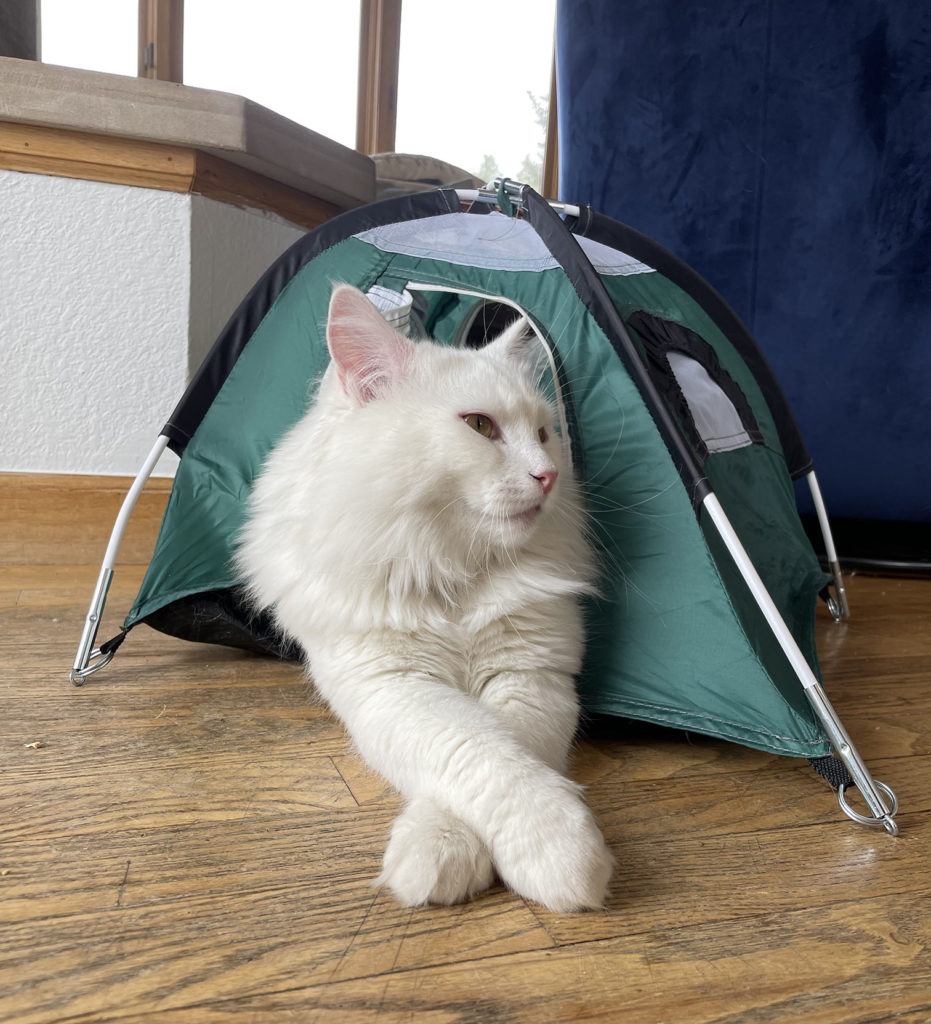
It’s a Tiny Tent for our cat!
Continue reading
This is such a silly post, because we are in love with this silly little thing.

It’s a Tiny Tent for our cat!
Continue reading
I love (LOVE) living so close to Rocky Mountain National Park. It’s the closest that I’ve ever lived to a national park, and every visit puts a big smile on my face. Needless to say, when I came across the Subpar Parks account, I couldn’t stop laughing.
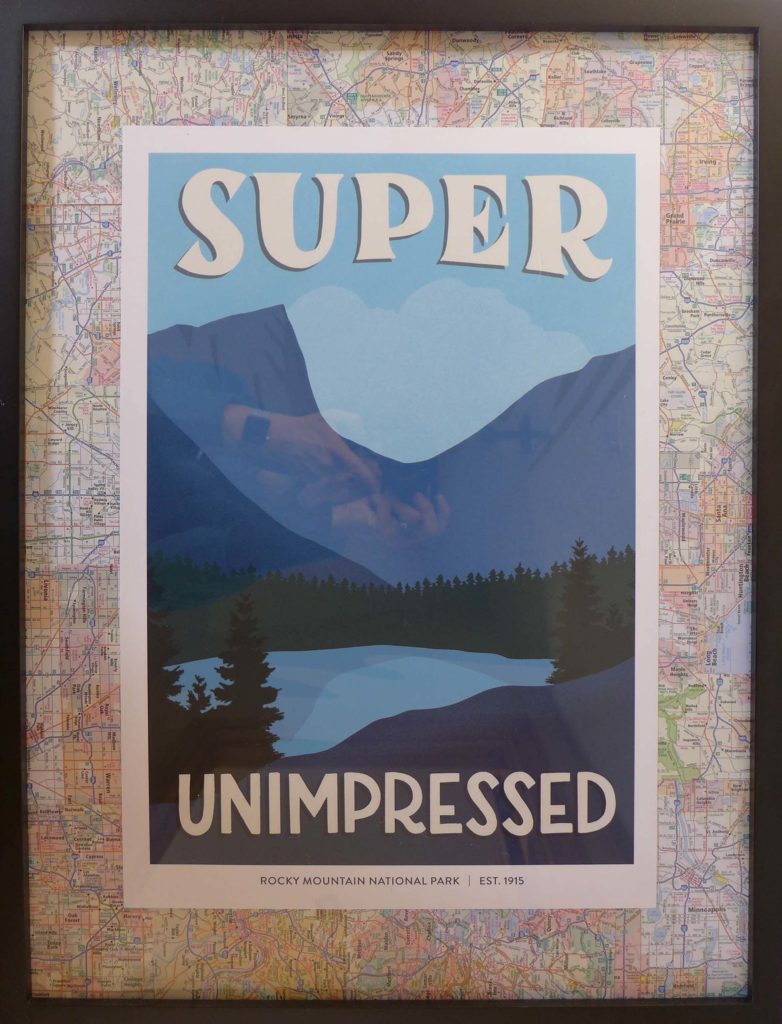
Illustrator Amber Share pairs negative reviews of the national parks with her own illustrations. She’s created an illustration for each US national park and has now moved on to parks in other parts of the world. I mean, I guess her work is funny. Would you believe me if I said I’m super unimpressed?
Continue readingWe’re popping in with a quick DIY : a holiday room spray! It’s simple, yet it totally adds to the ambiance when hosting visitors (this and a big glass of wine).
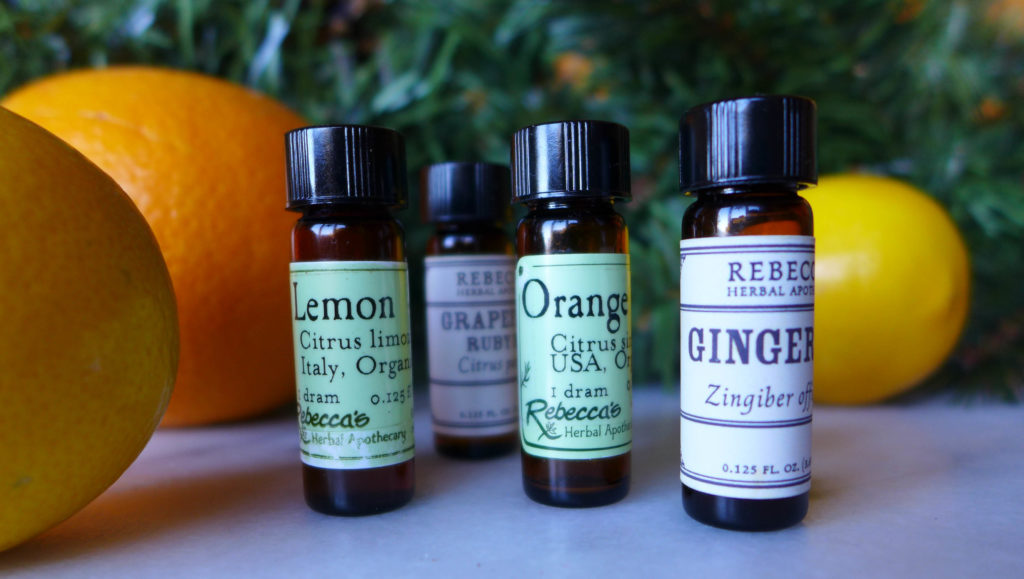
Honestly, I don’t regularly use room sprays, BUT whenever I have visitors stopping in, I like to know that the house is smelling nice. You can easily accomplish this with a simple essential oils room spray.
Were you one of those kids sitting there in high school geometry thinking about when you’d ever use that stuff? And now you’re crafting up a storm and haven’t thought about Pythagorean Theorem since. Well, today’s the day you’re going to put that famous formula to work! … now before you get the cold sweats, just know that you won’t *have* to use the formula (I’ll show you a trick), BUT if you want to impress your high school geometry teacher, then we’ll also whip out our calculators phones.
What am I talking about? Cutting angles for a super-simple DIY balsa wood mat.

I came up with this project out of desperation. My mom gave us a poster of an Egon Schiele print (I know what you’re thinking – why’d she cheap out and not buy the original? What a bum.), and I wanted to frame it to hang on the wall. The print itself was about 32″ by 21″, requiring at least a 36″ x 24″ frame. The problem was that I couldn’t easily find a mat large enough for the frame. I’m sure I could have ordered one from a framing shop or the framing counter at Michaels, but that would require talking to someone and explaining my problem. Did you know that young kids love to yell and scream at the exact moment you’re trying to talk to someone else?
Then I came up with an idea to shirk the traditional mat and make something more visually interesting out of balsa wood! If you haven’t worked with balsa wood before, it’s a very soft and lightweight wood that can be cut into thin sheets and used for any variety of craft projects (as well as having many structural uses beyond crafts). Balsa wood for crafts and model building is sold in Michaels, art stores, and some hardware stores. I bought the 36″ x 3″ x 1/16″ sheets for this project.
The basic overview of this project is that you’re going to center your print on the large piece of paper and place the pieces of the balsa mat around it, attaching the print and the balsa wood to the paper with double-sided tape. What I’m going to help you with below is making sure that the balsa wood ends are cut at the correct angle so that they fit together nicely in the frame.
Begin by decided how wide the balsa sheets will be on the top/bottom and sides of the print. For example, in my situation, I wanted the mat to be approximately 2.25 inches on the top and bottom, and only 1.5 inches on each side.
Cut the balsa sheets so that they are the length and width you want for your mat. Again, in my case I had two pieces of balsa that were 24″ x 2.25″ for the top and bottom, and two more pieces that were 36″ x 1.5″ for each side.
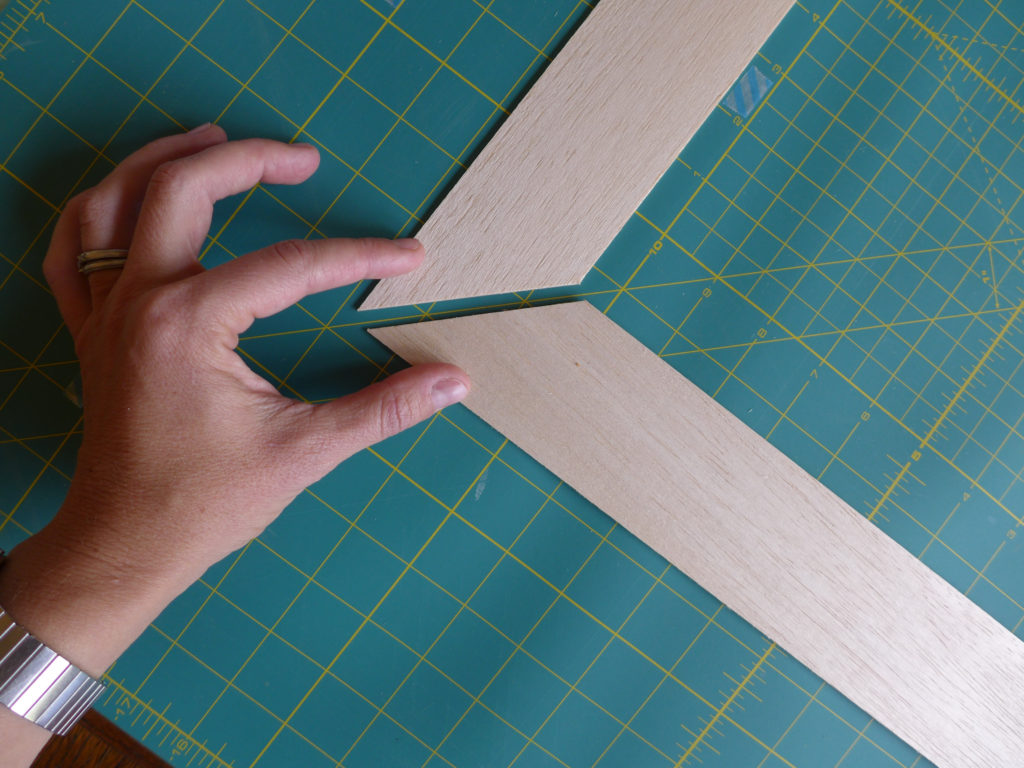
Once you have the four rectangles, you’ll have to cut the corner angles. If your sides and top/bottom pieces are the same width (i.e the mat will be the same width all the way around the picture), then you can easily cut the angles using the 45 degree line on your cutting mat as a guide as in the photo above.
BUT if the width of your side pieces doesn’t match the width of the top/bottom pieces, as in the example photos below, where the width of one piece measures 2.25″ and the width of the other measures 3″, then you’re going to have to use the Pythagorean Theorem to calculate the length of the corner angle.
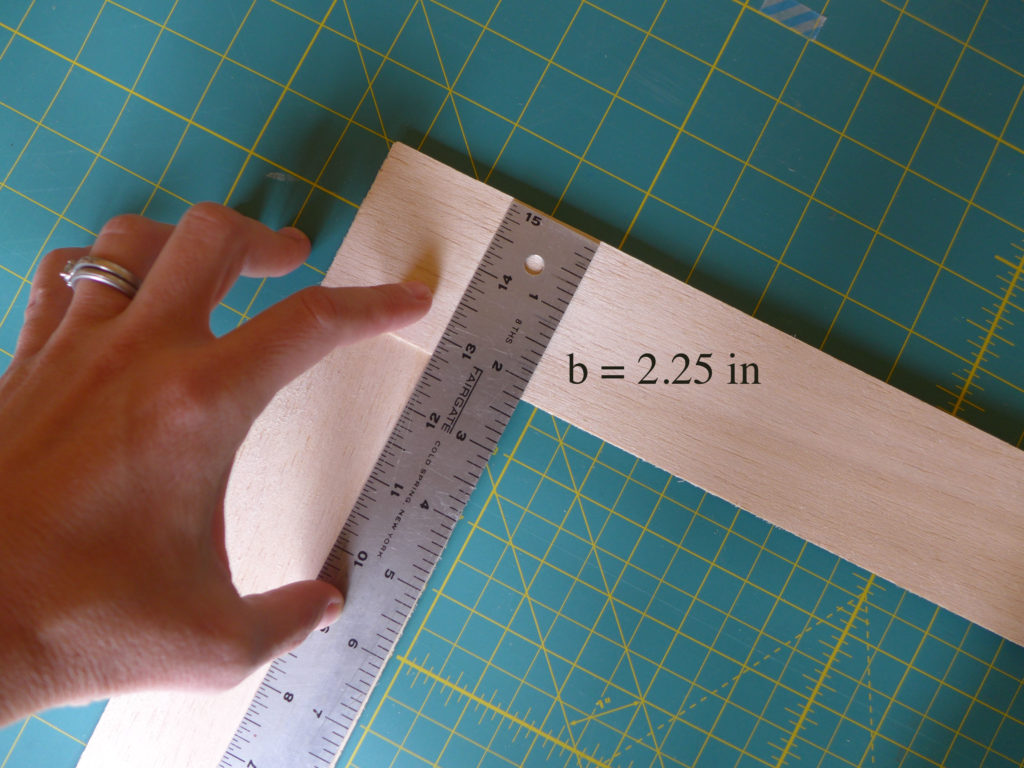

Good Old Pythagoras taught us that “a-squared + b-squared = c-squared”. Remember that? This formula only applies to right triangles, where one corner (the one opposite the hypotenuse) is a 90 degree angle. In this case, if we know the lengths of any two sides of the triangle, we’ll be able to find the length of the third using that equation.
Can you see the faint triangle drawn on the balsa wood in the photo below? That’s our right triangle with the 90 degree angle on the top right (bottom left), and we’re looking to calculate the length of the hypotenuse that runs from the outer corner of the mat to the inner corder.
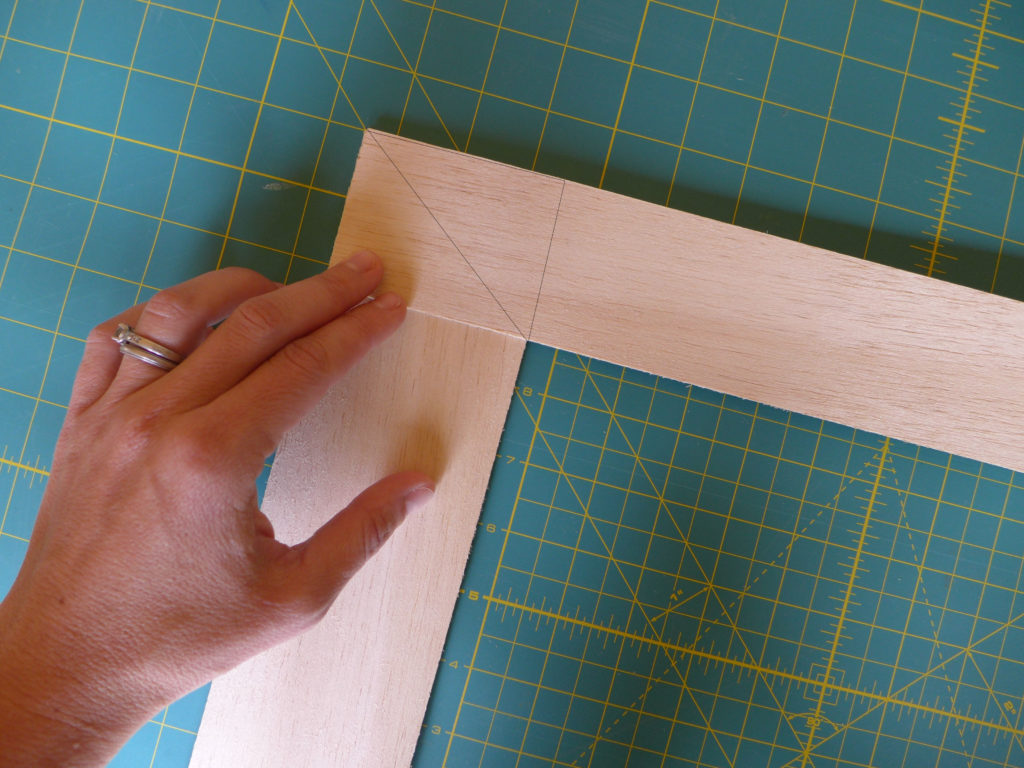

Applying the pythagorean theorem to this problem, I calculate a length of 3.75 inches for the corder cut, and by holding the ruler up to my mat, I see that that number matches the length of the cut from the outer to inner corners – it works! And as I mentioned in the photo, it’s worthwhile to note that the angle of our ruler doesn’t match the 45 degree line on the mat, so using that as your guide would give you corners that don’t line up.
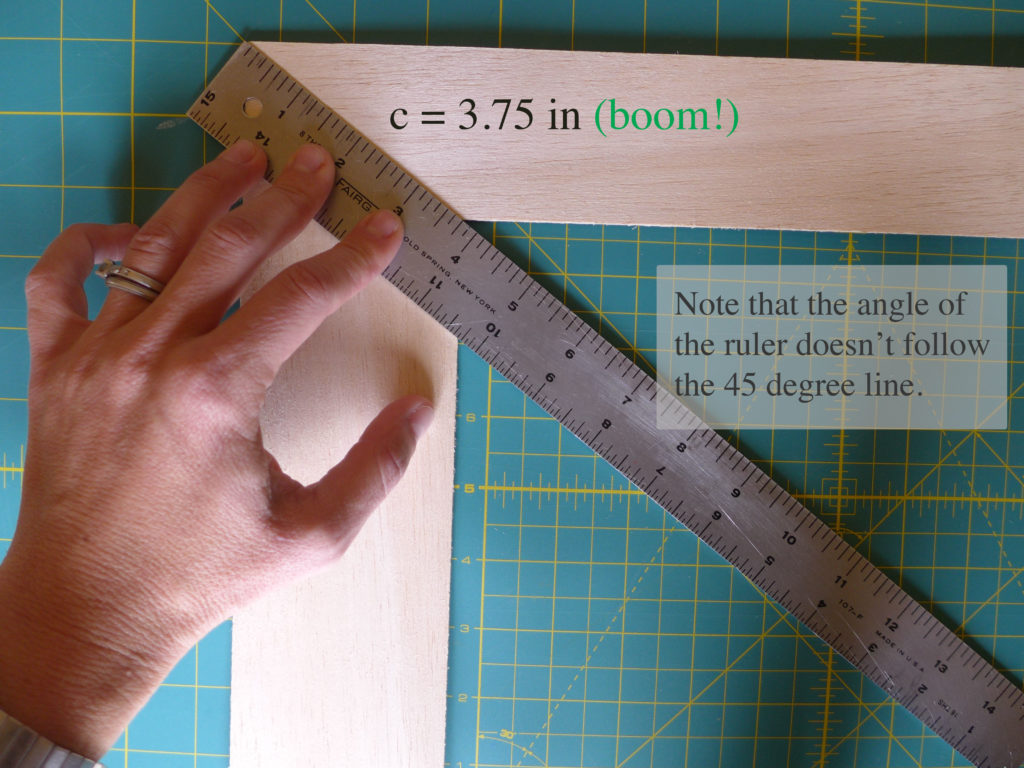
Ok, but as I’m sure you’ve already realized by now, you don’t *have* to make those calculations, you could just hold the ruler up as I’m doing below and use your exacto knife to cut along that edge without giving it’s length a second thought…. but come on, don’t you want to impress your better half? Or at least make your high school geometry teacher proud?
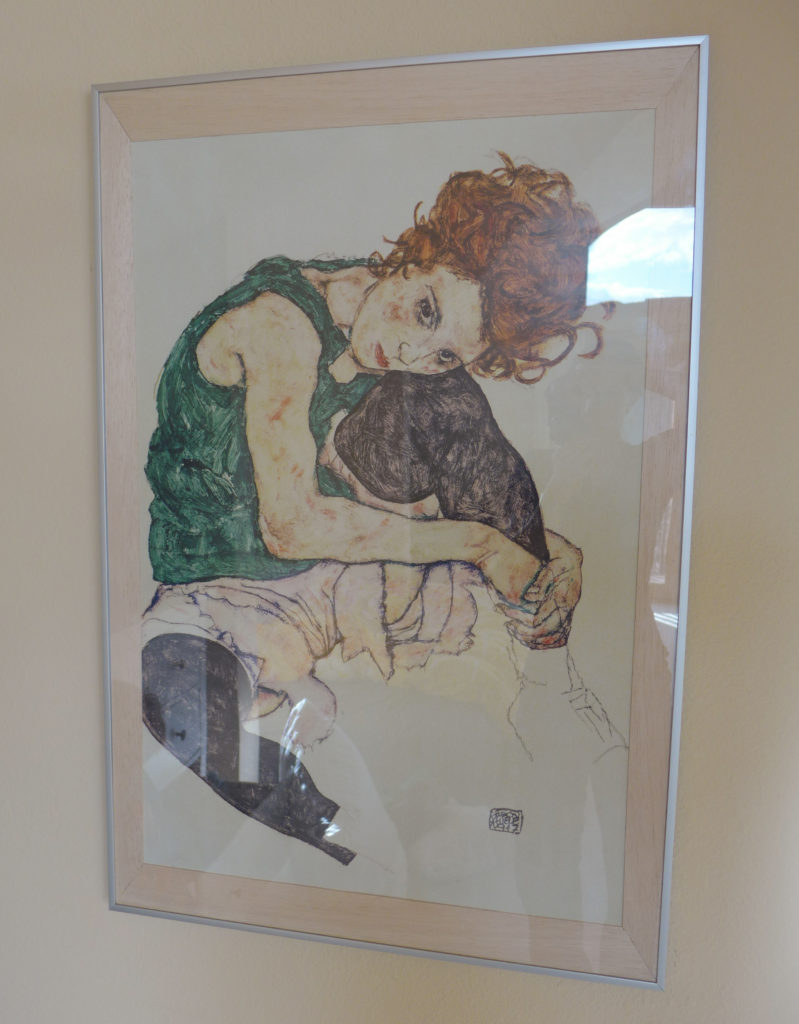
After your corners are cut, use the double-sided tape to secure the balsa pieces to the large piece of background paper, and then carefully place the whole thing (art and balsa mat attached to the background paper) into your frame, and your customized mat is done!
We have reached the height of summer here in the mountains. This is our hottest month, and while it seems dry out there, August is usually even drier. As you’ll see in the photos, there have been some real successes here in the garden, but what you don’t see is that there have also been a few failures/areas for improvement.
Fist, a surprising success : look at this clematis!
That vine grows in a small bed, that’s more like a container built into a little nook in our deck. It doesn’t have any irrigation, so the soil is extremely dry if not watered regularly. Last summer I was so busy with baby Luc, that I completely ignored this area. I barely watered it, and I didn’t care that the vine never grew (seriously, it grew maybe 10 inches and then died). Fortunately, with ample water, it came back in full force this summer and is covered in beautiful blooms!
I think that it also serves as a great reminder of the resilience of plants, and about how lush a garden can be with just a bit of care.
In the photo above, I’m showing off the echinacea that I planted this summer. I planted four of these around the yard (two in this bed and two near the pond). As you can see, these are successfully blooming, and I’m hoping to let their seed ponds fall into the bed for some self-seeding action. Unfortunately, one near the pond died – it suffered from a lack of watering and also an attack by our garden mice!…
The mice seem to be living in the beds along the deck, and I’m looking for ways to get rid of them or at least minimize their foraging. They’ve been eating some of the black-eyed susan flowers that I planted as well as the veggies in our veggie patch (so we haven’t been eating the vegetables, just to be safe). Any mice advice?
Behind the echinacea is an extremely large pot – I have two of these, and both are planted with a purple grass and those flowers. I’m totally blanking on the name of those flowers. It’s a nice combination that’s done well for me two years in a row.
The photo above shows one of my potting surprises. I planted these violas and pansies in early spring when I wanted something to fill the pot but knew that only something cold-hardy would do. I expected to fill the pots with something more heat tolerant once summer arrived, but these beauties keep flowering! They do look a bit leggy, but really not that bad, so I’m going to keep them here for a bit longer and then I’m hoping to transplant them to a shade spot under one of our Aspen trees, and see how well they do there (the violas should come back as a perennial).
As I surmised in my introductory post, we have raspberries that fruit on old growth (known as floricane-fruiting). Since I cut down all of the canes when we moved in (spring of 2015), new canes grew last summer and now they are all producing fruit! We have so many berries out there right now, only a small handful of really ripe ones so far, but more and more and ready every day.
I’m not sure what method I’m going to use for maintaining the raspberries. Part of me wants to cut down all of the canes again after this growing season (new and old growth), but that would meant that then we won’t have any fruit next summer. Or, I could go in and selectively thin the canes – cutting down the old growth and keeping the new growth. If I’m feeling ambitious and have the time, I may try this method… either way, I’ll keep you posted, and in the meantime, we’re enjoying this year’s bumper crop!
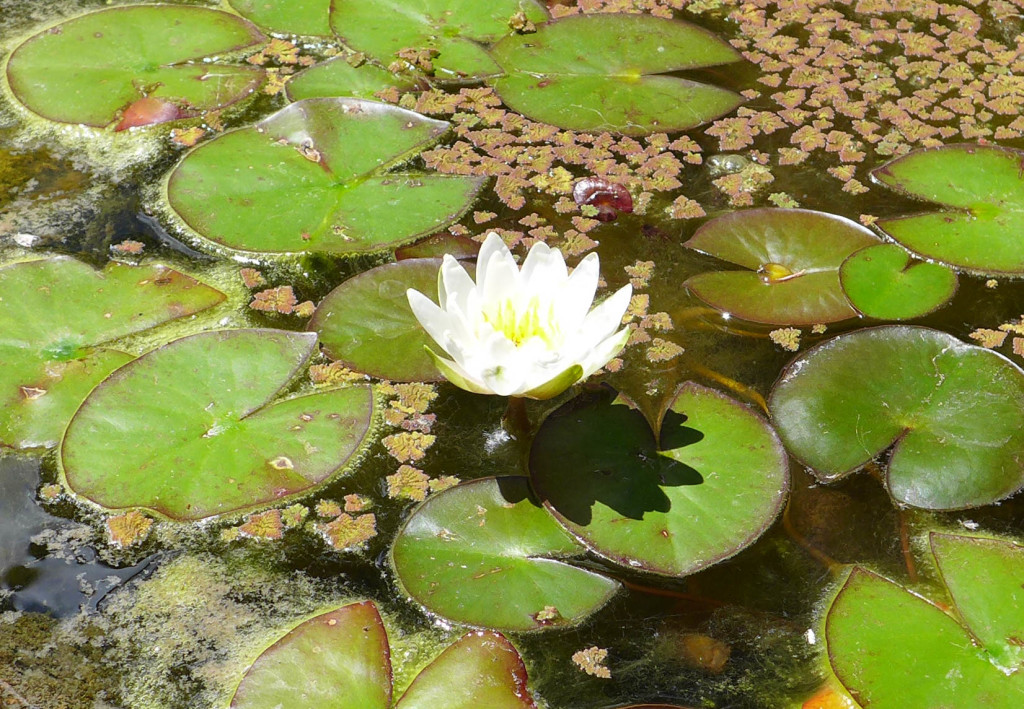
In the pond, our waterlilies are doing fantastic!… so is the algae! It’s a daily battle to go in and remove the string algae, but if I stay on top of it, the pond looks beautiful. We have these two lilies blooming right now, and I can see that the plants are multiplying – sending out new roots and plants within the containers. They seem to be such vigorous growers that I’m thinking about putting them in even bigger containers next year to encourage new plants.
The smaller plants floating around the lillies are the fairy moss. It’s growing well, but I think that next year I’ll order even more, because it’s not covering the pond as quickly as I’d like (I want it to cover the pond to help shade-out the algae).
A few of our other pond plants are doing well, but are still relatively small, so I’ll share updates on those in a future post.
I’d still like to add a couple of fish to the pond, but without more plant cover, I think they’d be immediate prey for the birds and other wildlife around our house…
I’m definitely highlighting the successes, because that’s what makes the gardening fun, and these are the areas my eyes turn to every time I walk out the door. Maybe I’ll share more of my “eh” areas in the next post. There are a few spaces where I was hoping to see big changes this year, but I’m starting to realize that I may have to settle for a slower evolution of the space.
Throughout this summer I’m excited to keep a journal documenting the growth, updates, and general observations of the gardens around our house. Since it’s the start of the season, I thought it would be appropriate to begin with a little overview of the outdoor space. Admittedly, the photos in this post aren’t that exciting, but I’m happy for the visual record they’ll provide as the season progresses.
We have a very large deck, a number of raised beds, a small-ish pond with a waterfall/stream powered by a pump that we can turn on and off. There’s a small rock path leading from the deck to the pond, and then this path continues down the side of the hill to our driveway. The rest of our outdoor space is rustic. Our house is built on the side of a hill/mountain, and fortunately there is no landscaping, instead, we just get to walk off the porch and and are immediately immersed in the native Rocky Mountain foothills ecosystem, full of evergreen trees, cactuses, native grasses and flowers, and small shrubs, all dotted with many rock outcroppings.
For anyone interested in the nitty gritty – I’m gardening in Boulder, CO in the foothills of the Rocky Mountains. We’re at about 6000 feet altitude, and in USDA zone 5b.
This is going to be my first real season gardening in Colorado. For the past two summers, I mainly grew herbs and a few things in pots on our deck, but this year my goal is to start improving the permanent spaces around our house. The main challenges that I want to keep in mind are water supply, animal predation, and length of the growing season.
I think I’m already doing a good job of reining in my expectations when it comes to that last item. If this were PA, I would have been actively working in the garden and adding new plants back in April. But here, we saw some of our biggest snow storms just a month ago! That definitely helped to keep my expectations in check. It also helps that the nurseries (knowing what’s what) don’t put out many of their plants until we’ve entered the window where putting them in the ground is ok. So, I’ve just started to add some perennials to the flower beds, and while it *feels* late, I think I’m right on schedule.
When it comes to plant choices, I want to create a responsible garden, so I’m really focusing on plants that will do well in a more arid environment. Fortunately for me, many of the flowers that I like also fit the bill as having low-water needs. After their first season, that is. You want to water plants well in their first season to ensure that they become established in the beds, growing nice deep roots that will help them in future seasons with lower water supplies. We have a drip irrigation installed throughout the beds, so that will help with watering but even so, I want to make sure we’ve installed a water-wise garden.
The other challenge that I’m trying to keep in mind are the foragers that frequent/live on our property. There are families of Mule Deer living in this area, and they love to graze in our yard. They are often eating the native grasses growing on the hillside, but they also walk right onto the deck and will look for anything tender growing in the garden. We also have rabbits living in the yard and they have no qualms about eating from the garden. Again, I’m lucky that many of the flowers I want to add to the garden are generally considered to be deer and rabbit-safe, but this is not the case for most vegetables, so as you’ll see below, I have a plan…
There are twelve tiered beds along one side of our deck, a few more that line the stairway from our driveway to the front door, and a couple more on the east-facing slope of our mountain below the house. We don’t see those last two on a daily basis, so I think I’ll end up ignoring them for most of this summer while I keep my focus on developing the plantings in the other beds.
All of the planted areas currently contain a collection of early-season bloomers (daffodils, snowdrops, hyacinths). There are a few peony plants, lavender, roses, and a lot of bearded irises.
This year I’m hoping to expand the variety of flowers growing in these beds. My plan is to add black-eyed susans, purple coneflowers, bee balm, catmint, yarrow, goldenrod, and milkweed. From my research, these all fit the bill as having low water needs and also being relatively unattractive to foraging from deer and rabbits. And while I’m trying to keep away some animals, I’m hoping to attract others. These flower choices are all attractive to a combination of hummingbirds, butterflies, and bees.
In addition to the flowers, we have a number of ornamental shrubs – butterfly weed, flowering hydrangea, and lilacs. I don’t plan on adding any more shrubs at the moment; I just want to maintain what we have.
We inherited a few edible plants in our garden. There are perennial herbs (sage, chives, oregano, and mint), a raspberry patch, and a few old strawberry beds.
A lot of people flinch when they here about mint in the garden because it’s so invasive. We’re fortunate in that all of our mint is planted in the rock pathway between our deck and the pond. It’s slightly shaded and is an area with soil that stays more moist than other beds (perfect for water-loving mint), and fortunately, it can’t really spread beyond that zone because it’s cornered by the pond, stream, and deck.
I didn’t know anything about raspberries before moving in, and I still feel like there’s a lot to learn. I know that there are some varieties that produce berries late in the season off of new canes and other varieties that produce berries throughout the season off of old growth. Right?
Last summer I cut all of these canes back. We only ended up getting two berries (no joke!), but they were delicious! It could have been that we didn’t water the area enough? Or it could be that this is a variety that produces berries on old growth? I didn’t prune anything this season and am going to see what happens. I’ve also signed up for a “small berries” class at a local nursery. I’m hoping to walk away from the class with both tips for growing and caring for our berry plants as well as information about different varieties that do well in our area.
I think our strawberry beds are all past their prime. I’ve read and been told that a strawberry plant only has a few years in it before its production slows down. Last year we had quite a few flowers, and I think I saw a berry or two, but we never got to any of them before the animals (this might be an unavoidable problem). I’d like to re-energize our beds, but I think I’ll wait to do anything until after the class.
When we moved in, every one of our raised beds had something growing in it – some were more full than others. Calder and I were both excited to completely empty at least one bed for growing veggies. We don’t have high expectations, or necessarily a high demand since we have a farm share, but we want to grow a few things that we can pick and eat, and more importantly to give the boys the exposure to growing something that they can pick and eat.
So this spring, I cleared one of the beds right off of the deck, moving most of the plants to open spaces in the surrounding beds. We then turned over the soil, added compost, and planted a few early-season veggies and herbs. Right now we have a little area of loose-leaf lettuces and another area of radish varieties (I’ve heard radishes are absurdly easy to grow, and I’m looking for an easy success in our first season). One side of the bed is dedicated to herbs – we have thyme and a hardy rosemary, if we’re lucky, both will be perennials in that space. We also added a dill and a fennel plant. In the middle of the bed I put in a couple of bok choy plants and one rainbow chard because we like to eat those greens. I think that as it gets too hot for the lettuce area, I’ll plant some basil in that zone.
This past weekend we built a couple of fenced boxes to fit over the vegetable bed. Nothing fancy just a super-simple frame using the cheapest wood from the hardware store with chicken wire stapled to it. I built the box in two pieces so that it would be easy to pick them up and move then aside when we’re working in that bed, and we can use only one if we only need half of the bed covered.
So that’s the state of the garden as of this week. Between the late snowstorms and recent rain, we’ve had a relatively wet spring, which is getting everything off to a really nice start (even if we are all going a bit stir-crazy inside!). The radish and lettuce seeds have sprouted! And all of the perennials I’ve planted thus far seem to be thriving. I’ll be excited to update this series throughout the summer as a record of how the beds change, and I’m hoping that the visuals will really help me each year as I think about what I’d like to add/change in the garden.
In the next post I’ll introduce you to our pond and my dreams for a big, lush water garden… they’re competing with Calder’s dream to turn the pond into our hot tub!
A couple of weeks ago we gave you a little tour of Alex’s finished bedroom with the promise that we’d be back to discuss the mural in greater detail. Well, today’s the day, and we’re ready to share both the highs and lows (there definitely were some!) of this project. If you want more background information, in the last post, we discussed why we wanted to do a big mural with some discussion of how the mountains fit in with our woodland theme.
As I mentioned in the last post, our inspiration for the mural came from this nursery designed by Emily Henderson. The first thing I did was to sketch out an overview of the mountain landscape that we would try to reproduce. Keeping in mind that odd numbers are more appealing to the eye than even, I went with five mountain peaks. I tried to stagger the heights, while keeping a natural perspective in mind, which meant making the background mountains shorter (these are also the ones that would be painted gray).
Hey there! If you’ve been following along, you may know that Calder and I bought a house in March and moved in a week or so before little Luc was born. It could have been a crazy and hectic time, but all in all, it wasn’t that bad (really!). We were lucky that our new house was in great shape did not require any major work. In fact, the only thing I want to change about the house are the colors of the walls. The walls are painted shades of beige. It’s nice enough that we can live with them for a while, but eventually I would love to brighten everything up and paint most rooms white.
To give you an idea of where I’m going: between the mountain views outside our windows, the wooden trim and furniture, and eventual white walls, I’m feeling inspired my many of the elements common to Scandinavian design. I want to add pops of color with the artwork on the walls, the furniture and other elements that can easily be changed within the rooms. That said, we took a big risk and added a huge mural across one wall in Alex’s room. Luckily it turned out great! Today I’m going to share snapshots from his room and in a follow-up post I’ll provide a more detailed tutorial and tips about how we painted the mural.
Summer flew by! Let me say here and now that this was the Summer of Kate. She created SO many posts this summer and I’m eternally grateful for her hard work and dedication to Live Seasoned so if you enjoyed this summer, know that it was mostly brought to you by Katie. We love summer for so many reasons: the sun, the berries, the beach, our birthdays, we could go on and on. We even added an extra week, did you notice? We both agree that autumn is pretty awesome too. The cool, crisp smell of the leaves in the air mixed with a cup of hot tea and every cliche fall activity we can think of, yep, that’s why autumn totally rocks. Before we move on to fall, we wanted to take a look back at summer and highlight our favorite posts. If you had a fave we didn’t mention, we would love to hear in the comments!
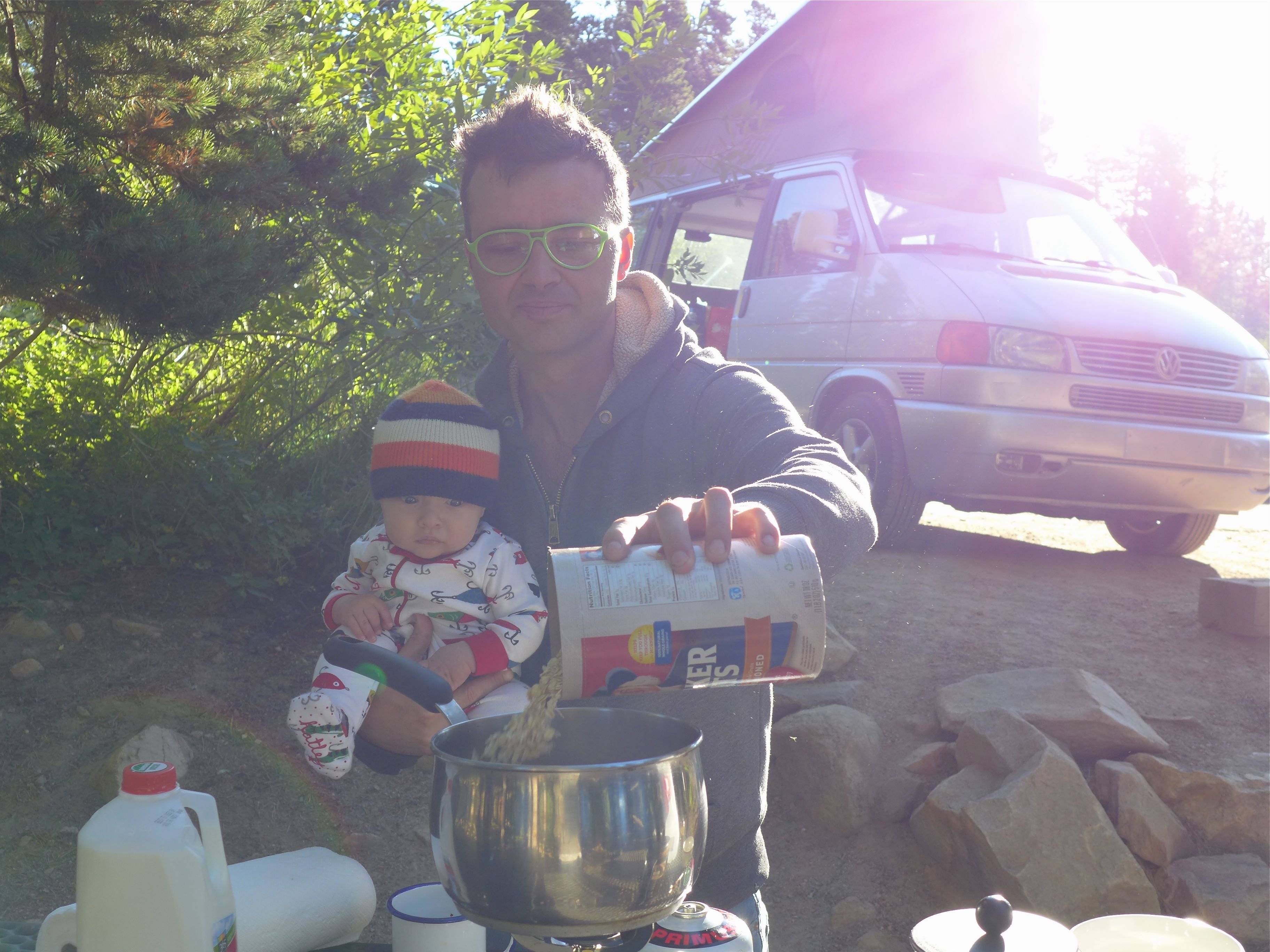

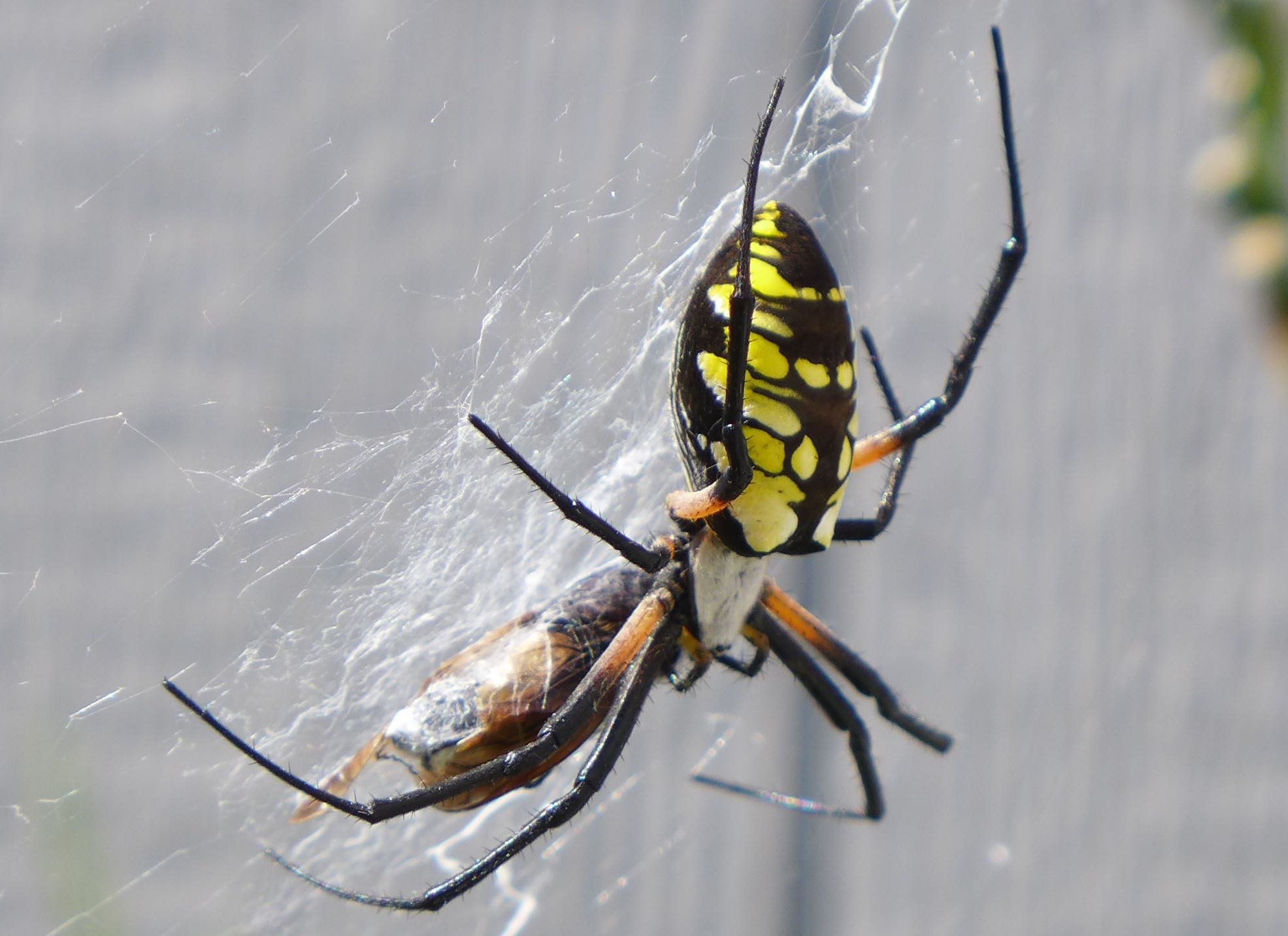
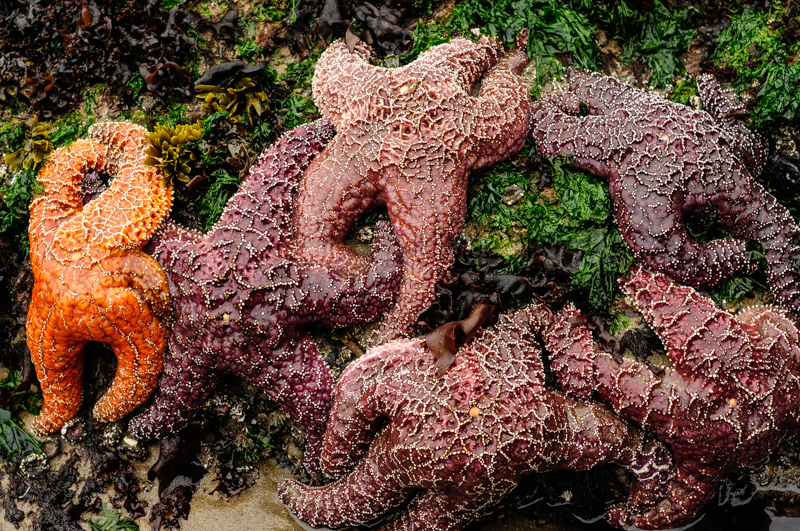
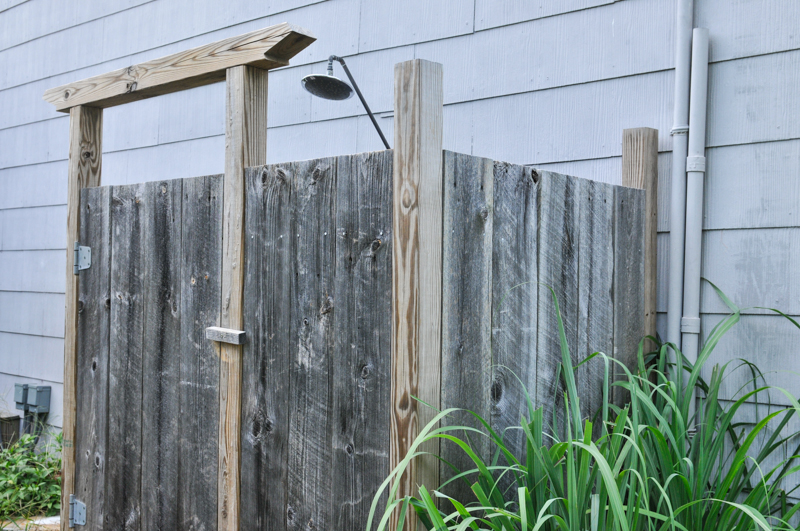
And that’s it, another summer in the books. We always think it goes by too fast, but that’s part of the reason why we blog. Having this record of the season helps to remind us that while we may not have had time for every adventure on our list, we still did a lot and had a fantastic time! We hope you did too. xo
While we love moths and try to live in harmony with nature, there’s something we just can’t come to peace with, and that’s moths eating our clothes (and yarn!). Since it’s moth week, it’s the perfect time to discuss the ugly underbelly of the moth world, as we like to think of them, and offer suggestions for keeping your house free of these pests.
If you’ve never suffered through infestations from these moths, count your blessings. On the other hand, if you have had the displeasure of trying to eradicate these moths from your house, we’re here to commiserate, and to share our strategies for keeping our closets moth-free.